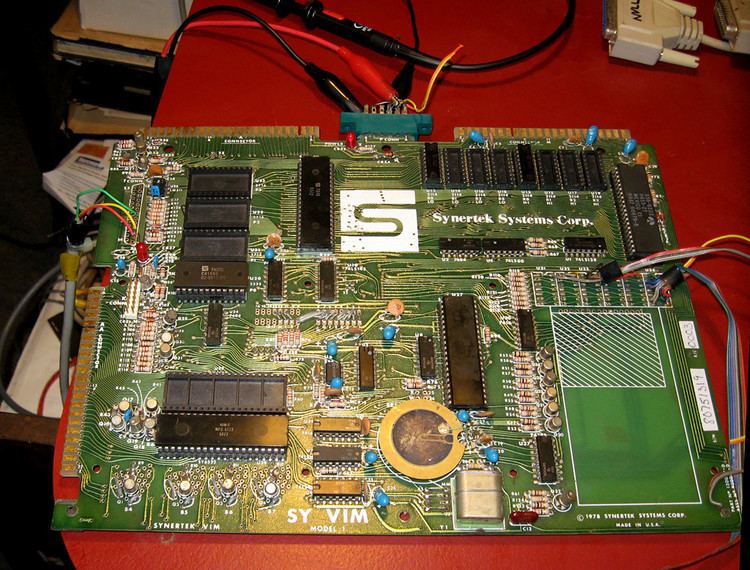Also known as VIM-1 | ||
 | ||
Type single board "trainer" computer Release date circa 1975; 42 years ago (1975) Introductory price US$238 (equivalent to $1,059 in 2016) | ||
The SYM-1 was a single board "trainer" computer produced by Synertek Systems Corp in 1975. It was designed by Ray Holt who also designed the first microprocessor chip set used in the CADC for the F-14 Tomcat. Originally called the VIM-1 (Versatile Input Monitor), that name was later changed to SYM-1.
The SYM-1 was a competitor to the popular MOS Technology KIM-1 system, with which it was compatible to a large extent. Compared to the KIM-1, enhancements included the ability to run on a single +5 volt power supply, an enhanced monitor ROM, three configurable ROM/EPROM sockets, RAM expandable on board to 4 kB, an RS-232 serial port, and a "high speed" (185 bytes/second, the KIM-1 supported about 8 bytes/second) audio cassette storage interface. It also featured on-board buffer circuits to ease interfacing to "high voltage or high current" devices.
One rather distinctive capability of the SYM-1 was its ability to allow an oscilloscope to be added to provide a 32 character display under software control. As explained in Chapter 7 of the "SYM Reference Manual", the vertical input, ground and trigger input of the oscilloscope were to be connected to the "Scope Out" connector AA on the SYM-1 board. The "Oscilloscope Output Driver Software" code provided in this chapter of the manual was to be entered into the SYM-1's memory and executed to enable the oscilloscope display. This code provided control of the oscilloscope display, as well as a rudimentary character set. Resistors R42 and R45 were to be adjusted to refine the displayed image.
Synertek sold ROMs which could be installed to add the BASIC programming language or a Resident Assembler/Editor (RAE). Synertek contracted with a company called Eastern House Software to port their Macro Assembler/Editor (MAE) into an 8 kB ROM. The author of MAE, RAE, and another version sold by Skyles Electric Works was Carl Moser. MAE was sold in various forms not only for the SYM-1 but also for other 6502-based computers including Commodore, Atari, KIM, and Apple. Other forms of MAE included a cross assembler for 6800 and 8085—and an offering of these cross assemblers was planned for RAE.
One of the more subtle features of the SYM-1 was the use of a look up table in the low memory of the 6502. This provided a vectoring function in its operating system to redirect subroutine calls to various input and output drivers, including interrupt servicing. Users were able to develop their own interface routines, and substitute new vectors for the original vectors in the startup UV-EPROM. This seamlessly maintained the normal operation of the board's monitor and languages such as Synertek Systems BASIC. One of the later home/education computers that used this concept extensively was the BBC Micro produced by Acorn Computers in the UK. Some of the other computer designers of this era failed to grasp the significance of this elegant use of vectors to the software mapping of new developments in hardware.
